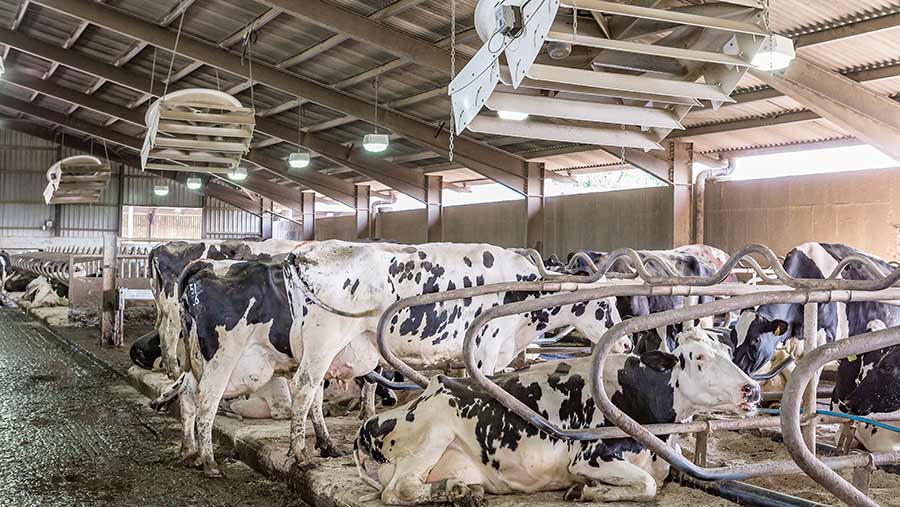Strategies to prevent heat stress in cattle
 © Richard Stanton
© Richard Stanton Record high temperatures last summer caught out livestock farmers in both indoor and outdoor systems, with cattle succumbing to debilitating heat stress.
Tell-tail signs of heat stress are lethargy and inactivity, and cattle will often stand with their heads bowed.
To avert potential problems with animal welfare and production this summer, beef expert Dr Norman Weatherup, and Jamie Robertson, a specialist in livestock building design, advise on how to actively manage systems to counter weather extremes.
1. Make tweaks to buildings to improve airflow
Cattle in poorly ventilated buildings are at risk of heat stress due to high humidity levels.
Beef animals at the finishing stage are the class of cattle most susceptible to heat stress, because they have the smallest lung capacity relative to bodyweight.
Jamie Robertson, of Livestock Management Systems, says consideration should be given to removing the roof ridge; this allows moisture to escape and is low cost and “immensely doable’’ option.
“Removal of the ridge will let more moisture out than the volume of rain that will ever enter,’’ he says, emphasising that roof work is dangerous and should only be carried out by competent persons.
The area of outlet required can be calculated using the AHDB Buildings Guide (PDF).
Opening sidewalls is more difficult as the building needs to provide protection in the autumn and winter months too. But farmers wishing to do so should provide the same area of inlet in each sidewall as is calculated for the area of outlet in the ridge.
“Turning space board cladding into proper Yorkshire board on the prevailing wind side of a building will give almost 50% more inlet area, gain control of rainwater ingress and reduce the cost of straw used,’’ Mr Robertson advises.
2. Provide adequate drinking water
Additional water supply is vital when demand is higher on hotter days as water intake can rise by 10-20%.
Dr Weatherup, senior technical policy adviser (agriculture) at the College of Agriculture, Food & Rural Enterprise (CAFRE), says water provision should be plentiful so animals are not queuing up at troughs.
Shading outdoor metal water troughs from the sun will allow the water to have a cooling effect on the cattle.
3. Consider feeding at cooler times of the day
Rumen fermentation is an underlying reason why cattle are prone to heat stress – normal digestive processes create heat and this reaches a maximum several hours after feed is consumed.
Dr Weatherup suggests moving feeding time in indoor systems to late afternoon or evening to allow fermentation during the cooler night temperatures.
This will also increase lung capacity for the cattle during the hotter periods of the day.
If cattle are fed several times a day, consider providing the largest proportion of the ration in the evening.
4. Restrict handling to early morning and late evening
The stress and physical activity of handling livestock during the hotter parts of the day will increase animals’ body temperature.
“If you need to select animals for slaughter, carry out all handling early in the morning,’’ Dr Weatherup advises.
When handling, don’t crowd cattle into pens because they need space for cooling; limit the period they are contained in those pens to under an hour, and always provide water.
5. Be prepared to adapt paddock design when grazing
Large fields subdivided into paddocks may create grazing blocks with no trees or hedges for shade.
“During periods of extremely strong sunshine the paddock rotation may have to be altered as animals need access to shade,’’ says Dr Weatherup.
Shade is particularly critical for older and younger cattle and for those that are dark haired and fleshy, as they are most prone to heat stress.
6. Use misters only in a suitable housing environment
As the ambient temperature rises, a cow sheds energy through respiration and sweating, but this evaporative cooling is a challenge when relative humidity is high, as is the case in the UK.
As more beef and dairy farmers have opted for high eave height in buildings, the air drawn in to the building by the stack effect has no benefit at animal level, so animals are not cooled by increased air movement.
Mr Robertson says misting works in UK conditions only if there is guaranteed air movement at cow level and the building has competent outlets.
“Misting cattle directly on to their backs will only work if cattle have access to a guaranteed airflow and the resultant moist air can leave the building,’’ says Mr Robertson.
“If it doesn’t it will end up as a wet spot somewhere else in the building, creating damp bedding and cubicles and mastitis.’’
